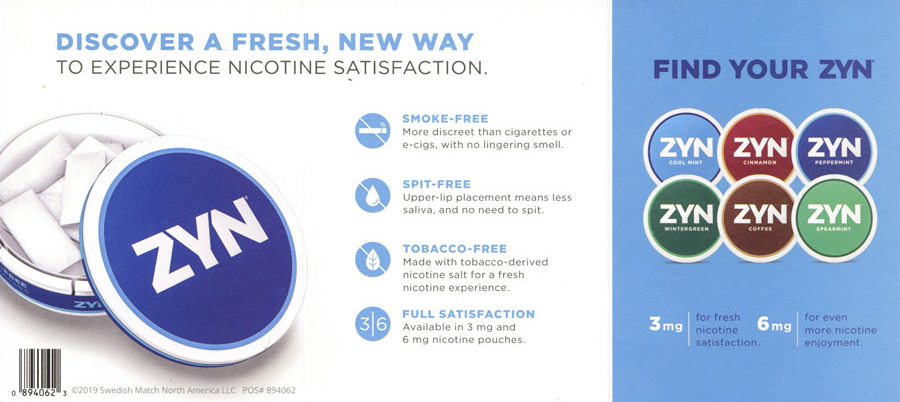Oral nicotine products entice customers with “tobacco free” claims, falsely implying lower risk
Increasingly popular oral nicotine products are frequently marketed as tobacco-free alternatives to smoking, claims that could imply lower-risk and are not authorized by the Food and Drug Administration, according to a recent Truth Initiative analysis of direct mail advertisements. Oral nicotine pouches and lozenges come in many flavors and are quickly gaining popularity and raising public health concerns.
The Truth Initiative study, which was published in Tobacco Control and is one of the first to examine marketing claims used to promote oral nicotine products to U.S. consumers, found that the majority of mailed ads for oral nicotine pouches or lozenges claimed that they did not contain tobacco leaf (55%) and that they were an alternative to other tobacco products (69%). Most advertisements (84%) also featured claims that the product could be used anywhere.

What is oral nicotine?
What is Velo?
Oral nicotine pouches and lozenges are a new category of tobacco product that includes brands such as Zyn, On! and Velo and come in many flavors. They are similar to snus – a type of smokeless tobacco pouch that does not produce saliva, making it spit-less – but, unlike snus, they do not contain leaf tobacco. The products are still derived from tobacco and contain nicotine, which is harmful to young people in any form, but due to the absence of tobacco leaf, the FDA does not classify it is a smokeless tobacco product. Some types of oral nicotine products are using synthetic nicotine that isn’t derived from tobacco leaf, raising additional concerns about misleading consumers who may assume that nicotine that doesn’t come from tobacco is somehow safer than tobacco-derived nicotine. The use of flavoring in tobacco products has been proven to appeal to youth, and sales data show that nicotine pouches are increasing in popularity.
Until now, there has been little insight into how tobacco companies market oral nicotine products like nicotine pouches or lozenges to consumers, including whether they use claims that could imply reduced harm.
To address the issue, researchers coded a sample of 50 direct-mail ads for the claims that oral nicotine products were an alternative to other tobacco products, could be used anywhere, were spit- or smoke-free, or that the product did not contain tobacco leaf. Researchers estimated that 38 million pieces of oral nicotine direct mail were sent to U.S. consumers between March 2018 and August 2020 for Velo (RJ Reynolds) and On! (Altria) nicotine pouches and Revel lozenges (RJ Reynolds).
How “tobacco-free” claims falsely imply products are healthier
Are tobacco free products healthier
Researchers found that 55% of oral nicotine direct-mail advertisements used claims like “tobacco leaf-free” pouches or highlighted the “simple approach” of introducing extracted nicotine from tobacco leaf into lozenges. In the past, the makers of cigarettes like American Spirit have relied on strikingly similar terms to market their products as “additive free,” “natural,” or “simple.” Because these descriptions made American Spirit cigarettes appear to be a healthier alternative to other cigarettes, the FDA required marketing copy for American Spirit to remove the terms “additive free” and “natural.”
Similarly, terms like “tobacco-free” in oral nicotine marketing could suggest products are healthier and lower risk to consumers. Using language that signals a tobacco product is “free of a substance” may meet one criteria of an unauthorized modified risk claim under FDA rules.
An alternative tobacco product
Can you swallow Zyn nicotine
Researchers found that direct-mail advertising positioned oral nicotine products as alternatives to existing tobacco products, including traditional smokeless products, cigarettes, and e-cigarettes.
About half (52%) of the direct mail pieces included claims that oral nicotine was “spit-free,” appearing to position oral nicotine products as an alternative to traditional smokeless products. About one-third (31%) described the product as “smoke-free,” implying that it is an alternative to cigarettes. Many ads contrasted oral nicotine pouches and lozenges to e-cigarettes, urging consumers to “forget about the chargers,” for example, potentially promoting oral nicotine as a product to use in combination with existing tobacco products or as a substitute for other tobacco products.
More research needed on “tobacco-free” claims and harm perceptions
Using language to highlight that oral nicotine is tobacco-free may convey oral nicotine products as lower-risk to consumers despite the lack of evidence or proper federal authorization that oral nicotine products are a modified-risk tobacco product.
“Our findings underscore the need for future experimental studies to examine the influence of claims that oral nicotine is “tobacco-free,” made through a “simple” process, and any other relevant ingredient-related claim (e.g., “pharmaceutical grade”) on harm perceptions among consumers,” the authors write. “Such evidence can further inform the FDA authority over false or misleading claims in tobacco product advertising.”
The availability of increasingly popular oral nicotine products in flavors coupled with evidence of marketing the products as alternatives to existing tobacco products calls for greater attention and regulation from the FDA.
*Image courtesy of Trinkets & Trash
More in tobacco industry marketing
Want support quitting? Join EX Program
By clicking JOIN, you agree to the Terms, Text Message Terms and Privacy Policy.
Msg&Data rates may apply; msgs are automated.


